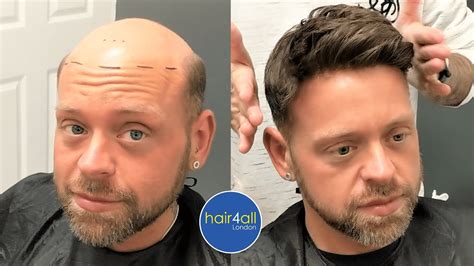Introduction
Male hair loss is a common concern, affecting millions of men worldwide. According to the American Hair Loss Association, approximately 50% of men will experience some degree of hair loss by the age of 50, and this number increases with age. While there are numerous causes of hair loss, including genetics, hormones, and lifestyle factors, the most common type is androgenetic alopecia, also known as male-pattern baldness.

Androgenetic alopecia is caused by a combination of genetic factors and the hormone dihydrotestosterone (DHT), which is produced when testosterone interacts with an enzyme called 5-alpha reductase. DHT binds to hair follicles, causing them to shrink over time and eventually stop producing hair.
Male Hair Units
Male hair units, also known as hairpieces or toupees, are a popular non-surgical hair replacement option for men experiencing hair loss. These units are designed to cover thinning or bald areas on the scalp, providing a natural-looking and seamless appearance.
Types of Male Hair Units
There are various types of male hair units available, each with its own unique characteristics and benefits. The most common types include:
Lace Front Wigs: These units feature a sheer lace front that provides a natural and invisible hairline. The lace material is breathable, allowing for comfortable wearing and easy styling.
Monofilament Wigs: Monofilament wigs are made from a thin, breathable material that closely resembles human skin. This allows for individual strands of hair to be hand-tied onto the base, creating a natural-looking and voluminous appearance.
Skin Base Wigs: As the name suggests, skin base wigs have a base made from a thin, polyurethane material that is designed to mimic the texture and appearance of human skin. These units offer a secure and realistic-looking fit.
Benefits of Male Hair Units
Natural Appearance: Modern male hair units are designed to blend seamlessly with the wearer’s own hair, providing a natural and undetectable appearance.
Convenience: Hair units are easy to wear and maintain. They can be removed and cleaned as needed, and can be styled and colored to match the wearer’s natural hair.
Variety of Styles: Hair units come in a wide range of styles, lengths, and colors, allowing wearers to find the perfect option to suit their preferences and lifestyle.
Self-Confidence: Hair loss can affect a man’s self-confidence and quality of life. Male hair units can restore the wearer’s hair, giving them a boost in confidence and self-esteem.
Choosing the Right Male Hair Unit
When choosing a male hair unit, it is important to consider the following factors:
Hair Type: Match the hair unit’s texture and color to your own hair as closely as possible.
Head Shape: Different types of hair units are designed to fit different head shapes. Choose a unit that conforms to your head shape for a secure and comfortable fit.
Lifestyle: Consider your lifestyle and activities when choosing a hair unit. If you are active or have frequent water exposure, you may want to opt for a more durable unit.
Budget: Hair units vary in price depending on the type, size, and materials used. Determine your budget before making a purchase.
Where to Buy Male Hair Units
Male hair units can be purchased from a variety of sources, including:
Hair Salons: Many hair salons offer hair unit services, including sales, fittings, and styling.
Online Retailers: Several reputable online retailers specialize in selling male hair units.
Specialty Wig Shops: Wig shops carry a variety of hair units, including those designed specifically for men.
Care and Maintenance of Male Hair Units
Proper care and maintenance are essential to ensure the longevity and appearance of male hair units. Here are some tips:
Cleaning: Hair units should be cleaned regularly, following the manufacturer’s instructions. Use a gentle shampoo and conditioner, avoiding harsh chemicals.
Styling: Hair units can be styled using heat tools, but take precautions to avoid damage. Use a heat protectant spray and avoid prolonged exposure to high heat.
Storage: When not in use, store hair units in a cool, dry place. Use a wig stand or storage box to prevent tangles and damage.
How to Wear a Male Hair Unit
Preparing Your Hair: Wash and dry your hair before applying the unit. Avoid using styling products, as they can interfere with the adhesive.
Applying the Unit: Apply adhesive to the base of the unit and press it onto your scalp. Hold the unit in place for several minutes to allow the adhesive to set.
Styling: Once the unit is secure, style it as desired using heat tools or hair products.
Removing the Unit: To remove the unit, gently peel it away from your scalp. Use adhesive remover to remove any remaining adhesive.
Troubleshooting Male Hair Unit Issues
If you encounter any issues with your male hair unit, here are some common solutions:
Unit is Too Loose: Tighten the adhesive bond by applying more adhesive around the edges of the unit.
Unit is Too Tight: Remove the unit and reapply it with less adhesive. You can also use a hair dryer to heat the adhesive and loosen it.
Unit is Itchy: Check for any irritation on your scalp. If necessary, apply an anti-itch cream or consult a dermatologist.
Unit is Losing Hair: Contact the manufacturer for a repair or replacement.
Conclusion
Male hair units provide a non-surgical and effective solution for men experiencing hair loss. With proper care and maintenance, these units can offer a natural-looking and self-confidence-boosting solution. By choosing the right unit and following the tips outlined in this guide, you can enjoy the benefits of a fuller, more vibrant head of hair.
Additional Resources
Here are some additional resources for those seeking further information or support on male hair loss:
- American Hair Loss Association
- International Society of Hair Restoration Surgery
- The Hair Loss Learning Center
